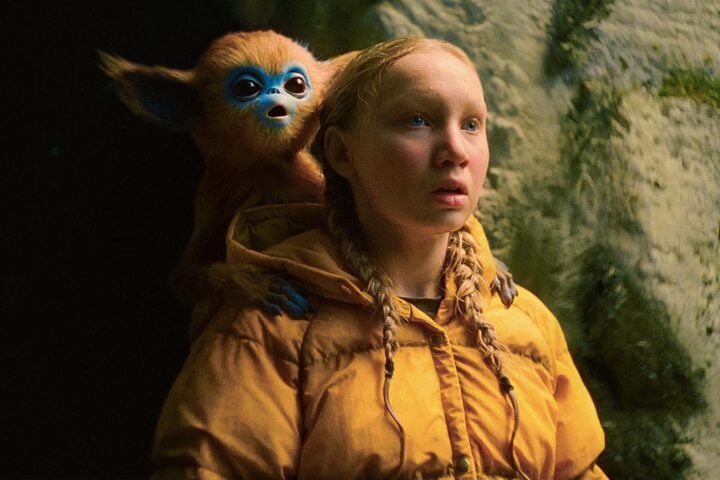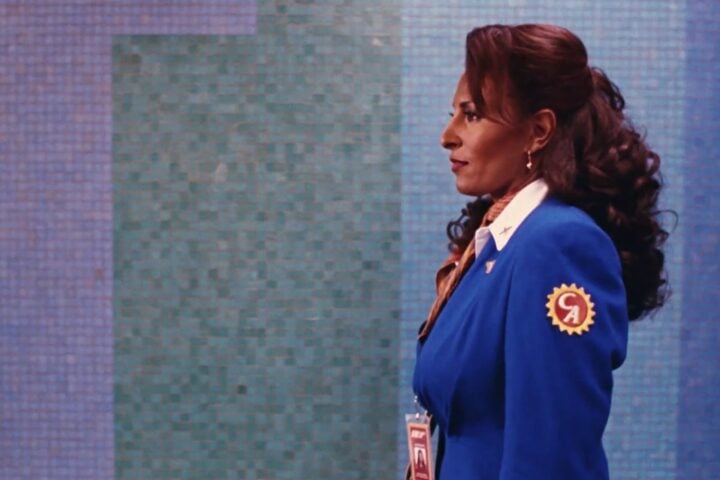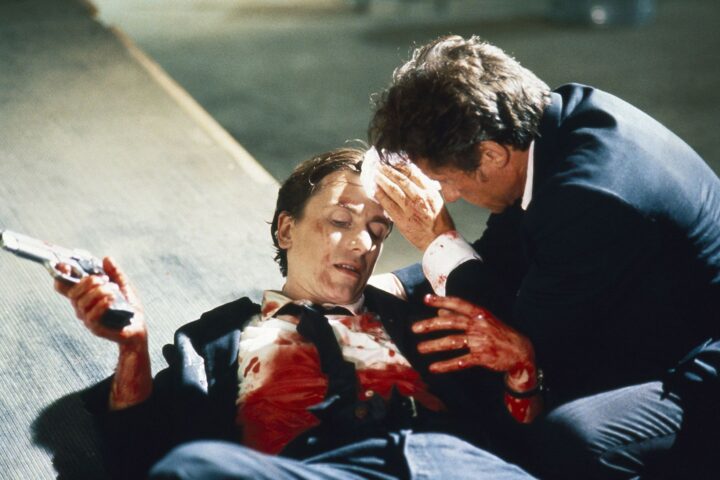In the American indie explosion of the 1990s, few filmmakers had a more compelling story than Robert Rodriguez. The Texan communications major had spent his time in college crafting homemade shorts and parlayed his enthusiasm into a feature he funded by raising a paltry $9,000, most of it gained from signing up for pharmaceutical drug tests. Shooting in the northern Mexican town of Ciudad Acuña, Rodriguez managed to push El Mariachi past the finish line under budget, pocketing nearly two grand of his meager put-up cash. Initially aiming to release the neo-western action film directly to the Spanish-language VHS market, Rodriguez got up the chutzpah to submit it to major Hollywood studios, one of which, Columbia Pictures, bought the rights and secured festival and theatrical exhibition.
That story is so inspiring for wannabe filmmakers that the film’s quality may as well be a secondary concern, but El Mariachi’s most remarkable facet may be how it remains so entertaining three decades after its release. Shot on 16mm and cast with mostly nonprofessional actors living in Ciudad Acuña, the fast-paced seriocomic thriller has a suitably lo-fi, guerrilla look befitting its tight shooting schedule and lack of resources. Nonetheless, there’s consistent ingenuity to Rodriguez’s methods—a full accounting of which can be found in his indispensable DIY book Rebel Without a Crew—as he tells the story of a mariachi (Carlos Gallardo) who finds himself hunted by a cartel thanks to a case of mistaken identity.
There are visible goofs and blown takes, a result of Rodriguez having used nearly every scrap of film at his disposal and needing to roll with what he had, and gunfights are often stitched together from the same handful of shots, only at different durations and speeds. The latter served a practical purpose, but in the final cut it aligns Rodriguez’s methods with those employed by Sam Peckinpah for some of his gnarliest westerns, prolonging moments of violence through repetition, deepening the impact of each muzzle flash and bullet hole.
Even the scenes of characters conversing or simply moving from one location to another have a jagged, propulsive quality thanks to each shot using as little celluloid as possible, and speed-ramping that leans heavy on both slow motion and sudden bursts of inhuman speed that recall similar techniques found in the Hong Kong cinema of the preceding decade. Narratively, El Mariachi is simplistic and fits comfortably within genre lines, but Rodriguez makes the limitations of the production into idiosyncratic signatures that give the film an enduring charm.
In much the same way that Sam Raimi used the success of The Evil Dead to make a more generously budgeted sequel that basically restaged, then dramatically expanded, the original, 1995’s Desperado is a narrative follow-up to El Mariachi that reconfigures the story of an innocent man gradually dragged toward violence into one of all-out action as the Mariachi (now played by Antonio Banderas) now traverses the world as a taciturn gunslinger out for the blood of cartel lords. As with its predecessor, the film uses a generic plot as little more than a skeleton on which to hang Rodriguez’s increasingly ambitious ideas for staging western shootouts.
Desperado’s $7 million budget can only seem lavish when compared to the chump change that made the first film possible, but Rodriguez gets a comparably vast amount of bang for his buck. Working with cinematographer Guillermo Navarro, the director levels up the classical beauty of his compositions while retaining his own antic, unorthodox approach to movement and flow.
The action scenes here could punch in the same weight class as the most expensive and exaggerated blockbusters of the mid-’90s, and some of their go-for-broke mania brings to mind John Woo’s American work. A climactic gunsight in which the Mariachi and some compadres (Gallardo and Albert Michel Jr.) take on a horde of henchmen with machine guns hidden in guitar cases is an absurd delight. Bolstered by smoldering work by Banderas and Salma Hayek, as the Mariachi’s love interest Carolina, Desperado is still the arguable high point of Rodriguez’s filmography and one of the greatest action movies of its era.
By the time Rodriguez circled back to the series for 2003’s Once Upon a Time in Mexico, he was firmly ensconced in Hollywood thanks to the Spy Kids series but still capable of working on a tight deadline and modest budgets. Having gotten a preview of then-new digital camera technology from George Lucas, Rodriguez recognized the format’s potential to offer high-quality images with minimal cost and setup, and by his own admission revived this series as a means to secure funding for what’s otherwise a pure experiment with the in-camera possibilities of HD.
Once Upon a Time in Mexico shows off a glimmer of technological potential amid a host of technical kinks not yet worked out through iterative upgrades. Color bleed is rampant, to the point it’s sometimes difficult to tell where, say, Willem Dafoe’s garish makeup to make him look like a Mexican drug lord ends and the smudging glow of nearby red brick begins. Contrast is so artificially heightened that on-location backdrops can look like rear projection or CGI.
On the positive side, the camera captures details like the individual sparks of muzzle flash that celluloid rarely displays, and in general the colors pop far more boldly than a comparably mobile 16mm camera would be able to achieve. Rodriguez also employs various post-production effects like a woozy swirl of the image to convey a drugged character’s perspective that could be done far easier and more immersively than manipulation of traditional film.
This might have more confidently marked a bold next step in Rodriguez’s career were the film itself not so sloppily assembled as an afterthought to mucking around with the camera’s settings. Banderas returns for an overburdened but undercooked story of the Mariachi seeking to avenge his murdered wife by taking on the corrupt Mexican general (Gerardo Vigil) and Dafoe’s kingpin. There are double-crosses, face-swaps, and Johnny Depp as a C.I.A. agent who shows a casual disregard for collateral damage, but none of it sticks together because Rodriguez is more interested in setting up a series of scenes with different lighting and color conditions than anything approaching a coherent story. The end result is something staged on a larger level than either of its predecessors but winds up feeling more insular and boxed-in than either.
More pressingly, Once Upon a Time in Mexico signaled the moment that Rodriguez devolved from a filmmaker who could synthesize all his influences into a unique vision to a mere pastiche artist. If Desperado felt indebted to Woo while displaying its own quirky stamp, this film just stages several blatant Woo rip-offs amid many more moments that crib from Sergio Leone’s Dollars trilogy. What should have been a new plateau in Rodriguez’s freedom from traditional filmmaking limits inadvertently was his most restrictive film to that point, and he would only double down on this derivative approach on future projects like the panel-for-panel recreations of Frank Miller’s Sin City or the regurgitated splattercore of Planet Terror.
Image/Sound
Arrow offers only Desperado on 4K UHD, with the other two films available only on 2K Blu-ray. This makes sense, as El Mariachi’s low-grade 16mm photography offers little room for upgrade, and Once Upon a Time in Mexico’s native 1080p shooting format would make 4K nothing more than an upscale. Desperado’s UHD disc looks spectacular: Colors are well balanced and skin tones look natural, and even the accompanying 2K Blu-ray copy reveals that the transfer is stabler then the one on Sony’s 2011 dual-release disc containing both it and El Mariachi.
As for El Mariachi and Once Upon a Time in Mexico, their 2K transfers accurately convey the strengths and limitations of their respective shooting formats. The former also sports a deeper image than the one found on the aforementioned Blu-ray, with more consistent black levels, but many exterior shots have a softness from the 16mm’s difficulty in capturing natural light. Meanwhile, Once Upon a Time in Mexico contains all the image artifacts inherent to the original HD capture, from moments of blotchy color to overcompensated contrast. By the same token, the considerable variations in color palettes are all presented clearly and show off the positive qualities of nascent HD video in capturing explosively saturated reds and greens.
El Mariachi’s soundtrack is cramped-sounding, albeit impressively clear and direct for such a low-budget feature thanks to Rodriguez filming without sound and then having the actors record their lines in post-sync. At the opposite end of the spectrum, Once Upon a Time in Mexico’s 5.1 audio has a persistent echoing quality in scenes that take place in spacious interiors. Elsewhere, though, the sound is punchy, and the crack of gunfire in particular always cuts through the mix with realistic detail. Best, of course, is Desperado, which sports the most traditional sound recording and mixing of the trilogy and which is enveloping in 5.1 surround, with dialogue crisp in the center of the mix and music and sound effects booming around it.
Extras
Robert Rodriguez was one of the first directors to fully embrace the potential of DVD to allow for a wealth of making-of features about a film’s making, and Arrow’s box set bursts at the seams with previously available commentaries, interviews, and featurettes ported over from earlier discs. Impressively, Arrow adds a bevy of new content, chiefly interviews for all three movies with Rodriguez and additional ones with various cast and crew members of each. The best material here is still Rodriguez’s commentaries, which unpack the concrete details of making each film and how each found him experimenting with new possibilities, as well as his “Ten Minute Film School” videos that act as educational demo reels for aspiring filmmakers. Also of interest is Rodriguez’s student short “Beadhead,” a Sam Raimi-esque comic fantasy that helped get his name on the local southwestern festival circuit. To his immense credit, Rodriguez has never forgotten his roots, and the extras here are not merely informative about the creation of the films but actively instructive to those who might like to follow in his footsteps.
Overall
Despite containing only one of the films on 4K UHD, Arrow’s box set feels like the definitive home video release of Robert Rodriguez’s trilogy.
Since 2001, we've brought you uncompromising, candid takes on the world of film, music, television, video games, theater, and more. Independently owned and operated publications like Slant have been hit hard in recent years, but we’re committed to keeping our content free and accessible—meaning no paywalls or fees.
If you like what we do, please consider subscribing to our Patreon or making a donation.




